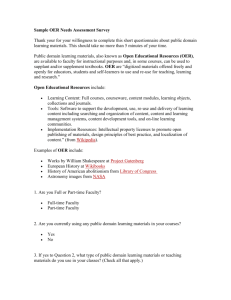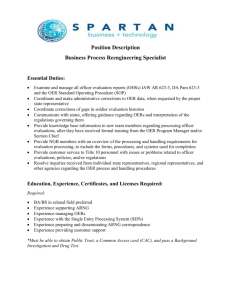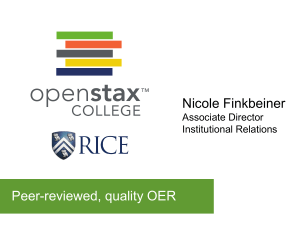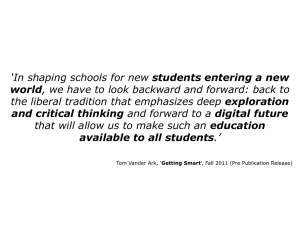Stout “Open” for Learning and Value in Education (SOLVE): An Open Textbook Pilot Heather Johnson Schmitz & Robert Butterfield University of Wisconsin‐Stout
advertisement
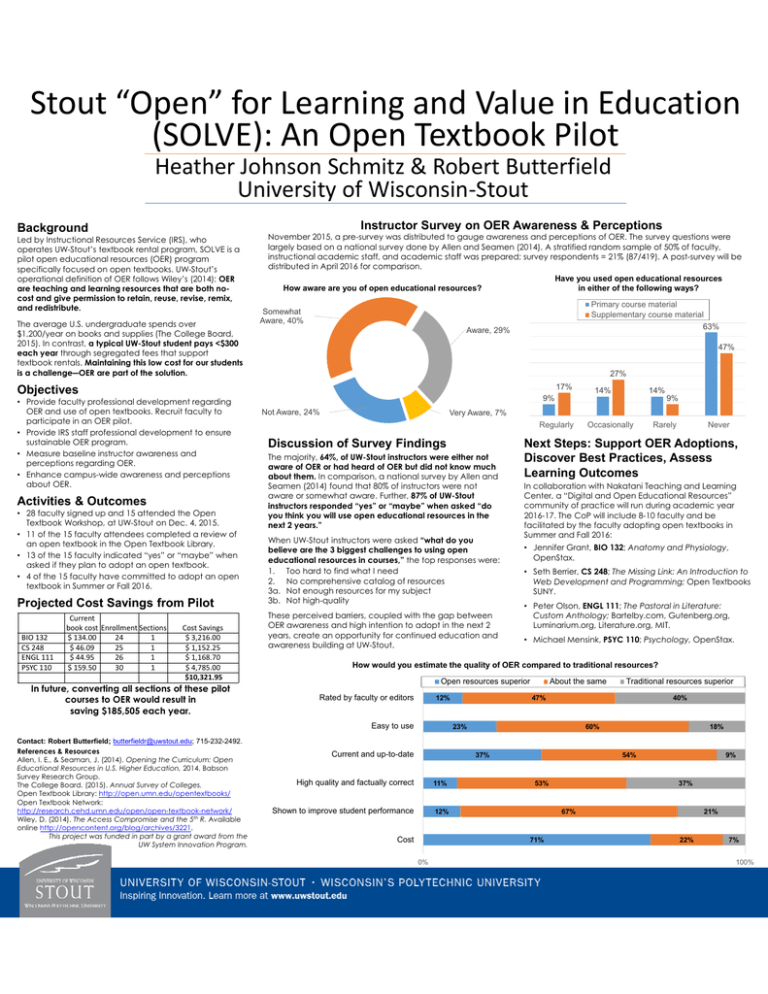
Stout “Open” for Learning and Value in Education (SOLVE): An Open Textbook Pilot Heather Johnson Schmitz & Robert Butterfield University of Wisconsin‐Stout Instructor Survey on OER Awareness & Perceptions Background Led by Instructional Resources Service (IRS), who operates UW-Stout’s textbook rental program, SOLVE is a pilot open educational resources (OER) program specifically focused on open textbooks. UW-Stout’s operational definition of OER follows Wiley’s (2014): OER are teaching and learning resources that are both nocost and give permission to retain, reuse, revise, remix, and redistribute. The average U.S. undergraduate spends over $1,200/year on books and supplies (The College Board, 2015). In contrast, a typical UW-Stout student pays <$300 each year through segregated fees that support textbook rentals. Maintaining this low cost for our students is a challenge―OER are part of the solution. November 2015, a pre-survey was distributed to gauge awareness and perceptions of OER. The survey questions were largely based on a national survey done by Allen and Seamen (2014). A stratified random sample of 50% of faculty, instructional academic staff, and academic staff was prepared; survey respondents = 21% (87/419). A post-survey will be distributed in April 2016 for comparison. Have you used open educational resources How aware are you of open educational resources? in either of the following ways? Primary course material Supplementary course material 63% Somewhat Aware, 40% Aware, 29% 47% 27% 17% Objectives • Provide faculty professional development regarding OER and use of open textbooks. Recruit faculty to participate in an OER pilot. • Provide IRS staff professional development to ensure sustainable OER program. • Measure baseline instructor awareness and perceptions regarding OER. • Enhance campus-wide awareness and perceptions about OER. Activities & Outcomes • 28 faculty signed up and 15 attended the Open Textbook Workshop, at UW-Stout on Dec. 4, 2015. • 11 of the 15 faculty attendees completed a review of an open textbook in the Open Textbook Library. • 13 of the 15 faculty indicated “yes” or “maybe” when asked if they plan to adopt an open textbook. • 4 of the 15 faculty have committed to adopt an open textbook in Summer or Fall 2016. Projected Cost Savings from Pilot BIO 132 CS 248 ENGL 111 PSYC 110 Current book cost Enrollment Sections $ 134.00 24 1 $ 46.09 25 1 $ 44.95 26 1 $ 159.50 30 1 Cost Savings $ 3,216.00 $ 1,152.25 $ 1,168.70 $ 4,785.00 $10,321.95 In future, converting all sections of these pilot courses to OER would result in saving $185,505 each year. 9% Not Aware, 24% 14% 9% Very Aware, 7% Regularly Discussion of Survey Findings The majority, 64%, of UW-Stout instructors were either not aware of OER or had heard of OER but did not know much about them. In comparison, a national survey by Allen and Seamen (2014) found that 80% of instructors were not aware or somewhat aware. Further, 87% of UW-Stout instructors responded “yes” or “maybe” when asked “do you think you will use open educational resources in the next 2 years.” When UW-Stout instructors were asked “what do you believe are the 3 biggest challenges to using open educational resources in courses,” the top responses were: 1. Too hard to find what I need 2. No comprehensive catalog of resources 3a. Not enough resources for my subject 3b. Not high-quality These perceived barriers, coupled with the gap between OER awareness and high intention to adopt in the next 2 years, create an opportunity for continued education and awareness building at UW-Stout. Occasionally Rarely Never Next Steps: Support OER Adoptions, Discover Best Practices, Assess Learning Outcomes In collaboration with Nakatani Teaching and Learning Center, a “Digital and Open Educational Resources” community of practice will run during academic year 2016-17. The CoP will include 8-10 faculty and be facilitated by the faculty adopting open textbooks in Summer and Fall 2016: • Jennifer Grant, BIO 132; Anatomy and Physiology, OpenStax. • Seth Berrier, CS 248; The Missing Link: An Introduction to Web Development and Programming; Open Textbooks SUNY. • Peter Olson, ENGL 111; The Pastoral in Literature: Custom Anthology; Bartelby.com, Gutenberg.org, Luminarium.org, Literature.org, MIT. • Michael Mensink, PSYC 110; Psychology, OpenStax. How would you estimate the quality of OER compared to traditional resources? Open resources superior Rated by faculty or editors 12% Easy to use Contact: Robert Butterfield; butterfieldr@uwstout.edu; 715-232-2492. References & Resources Allen, I. E., & Seaman, J. (2014). Opening the Curriculum: Open Educational Resources in U.S. Higher Education, 2014. Babson Survey Research Group. The College Board. (2015). Annual Survey of Colleges. Open Textbook Library: http://open.umn.edu/opentextbooks/ Open Textbook Network: http://research.cehd.umn.edu/open/open-textbook-network/ Wiley, D. (2014). The Access Compromise and the 5th R. Available online http://opencontent.org/blog/archives/3221. This project was funded in part by a grant award from the UW System Innovation Program. 14% About the same 40% 23% Current and up-to-date 60% 37% High quality and factually correct 11% Shown to improve student performance 12% Cost 18% 54% 53% 9% 37% 67% 71% 0% Traditional resources superior 47% 21% 22% 7% 100%
